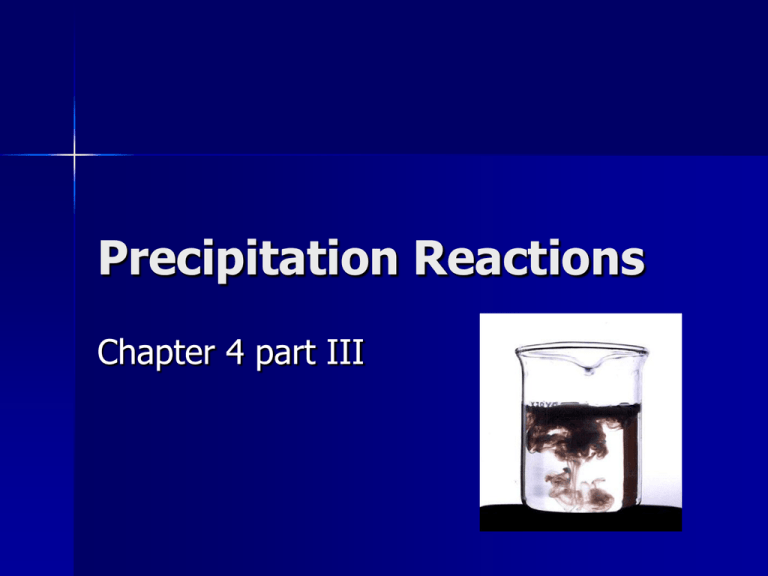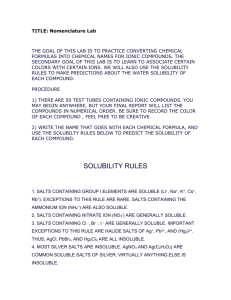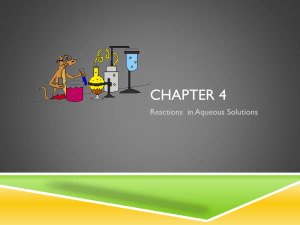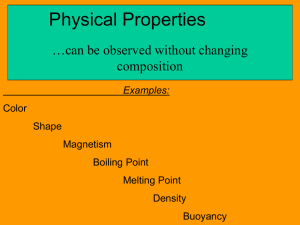Precipitation Reactions
advertisement

Precipitation Reactions Chapter 4 part III What are the 6 types of reactions ? Synthesis Decomposition Combustion Single replacement Double replacement Acid Base reaction Solution reactions Precipitation reactions: a subset of replacement reactions Acid Base reactions Oxidation reduction reactions: another subset of replacement reactions Precipitation Rxns: 2 solutions mix, and a solid is formed Precipitation Reactions When a solid containing ions dissolves in water, the ions separate. XY (s) X+ (aq) + Y- (aq) These ions move around independently in solution. Formation of Precipitates When products form the solid must have a zero net charge. It must contain both anions and cations. Most ionic materials contain only two types of ions, cations and anions. But in these double replacement reactions which, how does one identify the solid? Demo? Solubility Rules (Thanks to Professor Kenneth W. Busch) 1. Salts containing Group I elements are soluble (Li+, Na+, K+, Cs+, Rb+). Exceptions to this rule are rare. Salts containing the ammonium ion (NH4+) are also soluble. 2. Salts containing nitrate ion (NO3-) are generally soluble. 3. Salts containing Cl -, Br -, I - are generally soluble. Important exceptions to this rule are halide salts of Ag+, Pb2+, and (Hg2)2+. Thus, AgCl, PbBr2, and Hg2Cl2 are all insoluble. 4. Most silver salts are insoluble. AgNO3 and Ag(C2H3O2) are common soluble salts of silver; virtually anything else is insoluble. 5. Most sulfate salts are soluble. Important exceptions to this rule include BaSO4, PbSO4, Ag2SO4, and CaSO4. Solubility continued: 6. Most hydroxide salts are only slightly soluble. Hydroxide salts of Group I elements are soluble. Hydroxide salts of Group II elements (Ca, Sr, and Ba) are slightly soluble. Hydroxide salts of transition metals and Al3+ are insoluble. Thus, Fe(OH)3, Al(OH)3, Co(OH)2 are not soluble. 7. Most sulfides of transition metals are highly insoluble. Thus, CdS, FeS, ZnS, Ag2S are all insoluble. Arsenic, antimony, bismuth, and lead sulfides are also insoluble. 8. Carbonates are frequently insoluble. Group II carbonates (Ca, Sr, and Ba) are insoluble. Some other insoluble carbonates include FeCO3 and PbCO3. 9. Chromates are frequently insoluble. Examples: PbCrO4, BaCrO4 10. Phosphates are frequently insoluble. Examples: Ca3(PO4)2, Ag2PO4 11. Fluorides are frequently insoluble. Examples: BaF2, MgF2 PbF2. The Good Guys & Bad Guys Three types of equations Molecular equations: Gives the over-all reaction stoichiometry, but not necessarily the actual forms of the reactants and the products. HCl (aq) + NaOH (aq) H2O (l) + NaCl (aq) Complete Ionic Equation Represents as ions all reactants & products that are strong electrolytes. H+ (aq) + Cl- (aq) + Na+ (aq) + OH- (aq) H2O (l) + Na+ (aq) + Cl- (aq) Net Ionic Reaction This includes only those solution components undergoing a change. Spectator ions are not included. H+ (aq) + OH- (aq) H2O (l)




